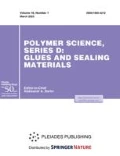Abstract
Experimental and theoretical study of the mutual effect of carbon nanotubes and parameters of ultrasound, which is necessary for dispersion of nanotube agglomerates, on the viscosity of polyester resin is carried out. The results of viscosity measurements at varying time of ultrasonic treatment of resin and time of cooling are presented. The viscosity of resin at ultrasonic field with a power density of 20 and 80 W/cm2 is compared. It is experimentally determined that the introduction of carbon nanotubes into polyester resin decreases its viscosity, while the power density of ultrasound field formed by an ultrasonic disperser, affects the viscosity of polyester resin during its modification with carbon nanotubes. The suggested theoretical model of modification of polyester resin with carbon nanotubes explains the decrease in viscosity as a result of the change of the cluster structure of liquid and the dependence of this decrease in the power density of an ultrasound field via the degree of dispersion of agglomerates into individual nanotubes.




Similar content being viewed by others
REFERENCES
L. P. Kobets, A. S. Borodulin, and G. V. Malysheva, “Study of microcapillary impregnation of carbon fibres by epoxy binders,” Fibre Chem. 1 (4), 311–315 (2016). https://doi.org/10.1007/s10692-017-9788-8
P. A. Belov, A. S. Borodulin, L. P. Kobets, and G. V. Malysheva, “Kinetics of fiber impregnation by a binder. Gradient generalization of Navier–Stokes–Darcy equations,” Polym. Sci., Ser. D 9 (2), 205–208 (2016). https://doi.org/10.1134/S1995421216020039
P. A. Belov, L. P. Kobets, and A. S. Borodulin, Impregnation kinetics of fibers with liquids: Simulation within the generalization of Navier–Stokes equations," Inorg. Mater.: Appl. Res. 5 (4), 403–406 (2014). https://doi.org/10.1134/S2075113314040182
A. S. Borodulin, “Polyester resins for production of goods from polymer composite materials by pressing methods,” Polym. Sci., Ser. D 6 (3), 269–270 (2013). https://doi.org/10.1134/S1995421213030052
A. S. Borodulin, G. V. Malysheva, and I. K. Romanova, “Optimization of rheological properties of binders used in vacuum assisted resin transfer molding of fiberglass,” Polym. Sci., Ser. D 8 (4), 300– 303 (2015). https://doi.org/10.1134/S1995421215040036
A. S. Borodulin, A. N. Marycheva, and G. V. Malysheva, “Simulation of impregnation kinetics of fabric fillers in the production of fiberglass articles,” Glass Phys. Chem. 41 (6), 660–664 (2015). https://doi.org/10.1134/S1087659615060036
M. E. Frantsev, “Design principles of a high-speed vessel hull made of composites according to the conditions of its weight efficiency and life cycle support,” Izv. Kaliningr. Gos. Tekh. Univ., No. 41, 196–208 (2016).
V. A. Tarasov, R. V. Boyarskaya, A. A. Ilyukhina, A. A. Karyagin, and A. A. Kudryavtsev, “An investigation of the possibilities of ultrasound intensification of the impregnation process of porous multiple glass units using LBS-4 bakelite lacquer,” Polym. Sci., Ser. D 10, 169–172 (2017).
G. V. Malysheva, L. P. Kobets, and A. S. Borodulin, “Rheological properties of binders filled with discrete carbon fibres,” Fibre Chem. 47 (6), 482–485 (2016). https://doi.org/10.1007/s10692-016-9718-1
V. A. Tarasov, M. A. Komkov, N. A. Stepanishchev, V. A. Romanenkov, and R. V. Boyarskaya, “Modification of polyester resin binder by carbon nanotubes using ultrasonic dispersion,” Polym. Sci., Ser. D 8 (1), 9–16 (2015). https://doi.org/10.1134/S1995421215010165
V. A. Nelyub and V. A. Tarasov, “Rheological model of viscous incompressible fluid with disperse fillers,” Int. J. Mech. Eng. Technol. 9 (13), 488–497 (2018).
J. O. Hirschfelder, Ch. F. Curtiss, and R. B. Bird, Molecular Theory of Gases and Liquids (University of Wisconsin, New York–London, 1954).
Author information
Authors and Affiliations
Corresponding author
Ethics declarations
The authors declare that they have no conflicts of interest.
Additional information
Translated by A. Muravev
Rights and permissions
About this article
Cite this article
Tarasov, V.A., Gerasimov, N.V., Jia, Z. et al. The Physical Nature of the Decrease in Viscosity of Polyester Resin during Nanomodification in Ultrasound. Polym. Sci. Ser. D 13, 141–145 (2020). https://doi.org/10.1134/S1995421220020239
Received:
Revised:
Accepted:
Published:
Issue Date:
DOI: https://doi.org/10.1134/S1995421220020239



